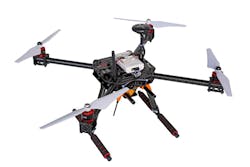Thanks to open-source platforms, developers can stand on the shoulders of software giants to build bigger and better things. Linux is probably the biggest example, but a host of other open-source platforms are out there as well. One of those is the PX4 autopilot, which is the heart of many drones.
PX4 runs on a number of platforms, including Gumstix’s AeroCore 2 for NVIDIA Jetson that supports a Jetson TX2. One of the latest platforms is NXP’s RDDRONE-FMUK66 (Fig. 1), which is designed to support NXP’s new HoverGames competition. This flight management unit (FMU) is based on NXP’s Kinetis K66 Arm Cortex-M4 microcontroller. The FMU can control servos and supports the two-wire 100Base-T1 automotive Ethernet standard.
1. The heart of the kit is a flight management unit (FMU) based on NXP’s Kinetis microcontroller running the PX4 open-source software.
The FMU is paired with NXP’s drone (Fig. 2). They’re all part of a kit designed for the HoverGames. The challenge for this year’s HoverGames is to develop a drone system to assist firefighters and other first responders. It’s somewhat open-ended compared to more specific goals of other robotic competitions, but the hardware platform lends itself to more advanced solutions.
2. NXP delivers a drone kit for those competing in its HoverGames competition.
In particular, all of the kit’s parts have been integrated, which is a big task. Developers could spend months just getting hardware and software to the point where a drone is flying. This includes the use of the PX4 autopilot software that’s managed by DroneCore.org, which is also part of the Linux Foundation. In addition, DroneCode.org hosts projects like MAVLink, a communication protocol used by PX4, and a ground-station control system.
A host like an i.MX 8 or NVIDIA Jetson TX2 running the Robot Operating System (ROS) can control the PX4 system via MAVLink using MAVROS. The FMU has headroom for applications, but it lacks the horsepower to analyze video streams that one of these other hosts can easily handle.
HoverGames competitors will build on many open-source platforms and protocols. They will be able to concentrate on applications such as thermal imaging to identify people and animals, or track the progress of fires to provide firefighters and first responders with information they would normally lack without drone support.
The FMU will likely crop up in other projects, since the hardware and software are applicable to other robotic applications as well. I’m looking forward to seeing the winners of this year’s competition.



